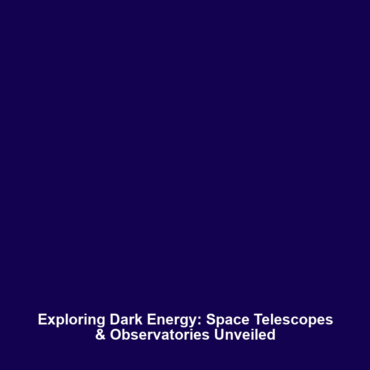Space Telescopes and Observatories Studying Dark Energy
Introduction: Understanding dark energy is one of the most pressing challenges in modern astrophysics. Space telescopes and observatories such as Euclid and the Rubin Observatory are pioneering efforts in probing this mysterious force that accelerates the universe’s expansion. These advanced technologies not only enhance our understanding of dark energy but also contribute to the broader field of dark matter research. With their cutting-edge capabilities, they promise to unlock new insights into the universe’s structure, evolution, and ultimate fate.
Key Concepts
Understanding Dark Energy
Dark energy is theorized to constitute approximately 68% of the universe and is believed to be responsible for its accelerated expansion. Space telescopes like Euclid and the Rubin Observatory are crucial in providing the observational data needed to study dark energy’s effects and properties.
Space Telescopes and Their Role
These observatories utilize advanced imaging technology and extensive survey capabilities to map the universe, focusing on galaxies’ distribution and the cosmic microwave background. Their findings help astrophysicists understand the fundamental parameters influencing dark energy’s behavior in relation to dark matter.
Applications and Real-World Uses
The applications of space telescopes and observatories in understanding dark energy are vast:
- Cosmic Surveys: Both Euclid and the Rubin Observatory will conduct large-scale surveys to create detailed maps of the universe, identifying galaxy clusters and dark energy’s influence on them.
- Supernova Research: These observatories will study Type Ia supernovae as standard candles to measure cosmic distances and refine our understanding of the expansion rate of the universe.
- Gravitational Lensing: Using gravitational lensing techniques, researchers can study how dark energy affects light from distant galaxies, providing insights into its properties.
Current Challenges
While space telescopes like Euclid and the Rubin Observatory are invaluable, they face several challenges in studying dark energy:
- Limited technological resources can impede the collection of high-quality data.
- Environmental factors, such as light pollution and atmospheric conditions, can affect observational accuracy.
- Complex data interpretation requires advanced computational methods and analytics to derive meaningful results.
Future Research and Innovations
Looking ahead, space telescopes and observatories are poised for groundbreaking innovations that may revolutionize our understanding of dark energy:
- Next-Generation Surveys: Future missions are expected to improve upon existing technologies, enhancing survey efficiency and data quality.
- AI and Machine Learning: Implementing AI-driven algorithms may aid in better data analysis, helping researchers uncover hidden patterns in energy signatures from celestial objects.
- New Collaborative Efforts: Integration with ground-based observatories could yield unprecedented insights by combining data from various sources.
Conclusion
Space telescopes and observatories, such as Euclid and the Rubin Observatory, represent the forefront of research into dark energy and dark matter. Their innovative approaches are not only critical for advancing scientific knowledge but also influence technologies used in various fields. For further exploration of this topic, consider reading more about related topics in dark matter and dark energy studies.
